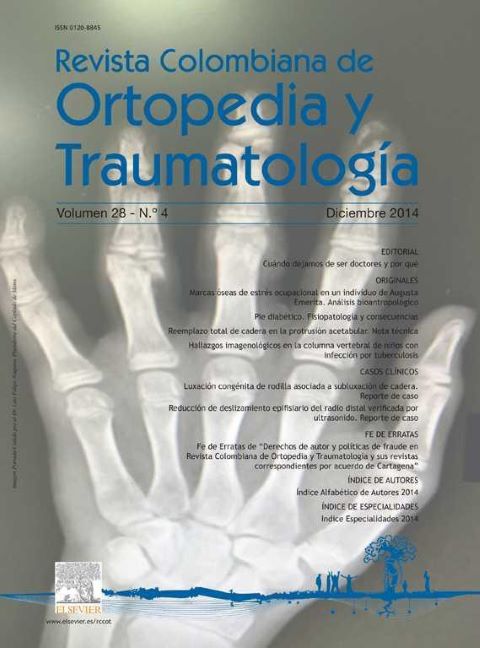Imaging findings in the spine of tuberculosis infected children
DOI:
https://doi.org/10.1016/j.rccot.2015.05.002Keywords:
tuberculosis, spine, tuberculous spondylitis, nuclear magnetic resonanceAbstract
Introduction: Tuberculosis has high incidence worldwide, 5% of cases in the spine, of which 30% are children. Tuberculous spondylitis is a major problem due to the high morbidity, bone destruction and potential associated neurological impairment.
Objective: The aim of this study is to describe the imaging findings in childhood spinal tuberculosis.
Materials and methods: A case series study including 4 patients was performed, evaluating imaging findings in children under 13 years with vertebral tuberculosis treated at a high complexity hospital between 2008 and 2012. A specialized neuroimaging radiologist evaluated the images.
Results: All patients had vertebral involvement of at least two levels. Vertebral collapse and kyphosis deformity were present in 75% of the patients. The most frequently involved segments were thoracic and lumbar, both with 75% incidence, no cases in cervical and sacral spine were found.
Discussion: The weakness of the study was that only a few cases were included, however the findings were similar to those reported in worldwide medical reports. What was found shows that the diagnosis and intervention of childhood spinal tuberculosis is getting late, when it is not possible to treat any different to the functional consequences.
Evidence level: IV
Downloads
References
Andronikou S, Jadwat S, Douis H. Patterns of disease on MRI in 53 children with tuberculous spondylitis and the role of gadolinium. Pediatr Radiol. 2002;32:798-805. https://doi.org/10.1007/s00247-002-0766-8
Pui MH, Mitha A, Rae WI, Corr P. Diffusion-weighted magnetic resonance imaging of spinal infection and malignancy. J Neuroimaging. 2005;15:164-70. https://doi.org/10.1111/j.1552-6569.2005.tb00302.x
Loke TKL, Ma HTG, Chan CS. Magnetic resonance imaging of tuberculous spinal infection. Australas Radiol. 1997;41: 7-12. https://doi.org/10.1111/j.1440-1673.1997.tb00459.x
Jung NY, Jee WH, Ha KY, et al. Discrimination of tuberculous spondylitis from pyogenic spondylitis on MRI. Am J Roentgenol. 2004;182:1405-10. https://doi.org/10.2214/ajr.182.6.1821405
Desai SS. Early diagnosis of spinal tuberculosis by MRI. J Bone Joint Surg Br. 1994;76:863-9. https://doi.org/10.1302/0301-620X.76B6.7983108
Moorthy S, Prabhu NK. Spectrum of imaging in spinal tuberculosis. Am J Roentgenol. 2002;179:979-83. https://doi.org/10.2214/ajr.179.4.1790979
Jain AK, Sreenivasan R, Saini NS, et al. Magnetic resonance evaluation of tubercular lesion in spine. Int Orthop. 2012;36: 261-9. https://doi.org/10.1007/s00264-011-1380-x
Yusof MI, Hassan E, Rahmat N, Yunus R. Spinal tuberculosis: the association between pedicle involvement and anterior column damage and kyphotic deformity. Spine (Phila Pa 1976). 2009;34:713-7. https://doi.org/10.1097/BRS.0b013e31819b2159
Naim-Ur-Rahman Jamioom A, Jamjoom ZA, et al. Neural arch tuberculosis: radiological features and their correlation with surgical findings. Br J Neurosurg. 1997;11:32-8. https://doi.org/10.1080/02688699746663
Wasay M, Arif H, Khealani B, et al. Neuroimaging of tuberculous myelitis: Analysis of ten cases and review of literature. J Neuroimaging. 2006;16:197-220. https://doi.org/10.1111/j.1552-6569.2006.00032.x
Downloads
Published
How to Cite
Issue
Section
License
Copyright (c) 2024 Revista Colombiana de ortopedia y traumatología

This work is licensed under a Creative Commons Attribution 3.0 Unported License.




